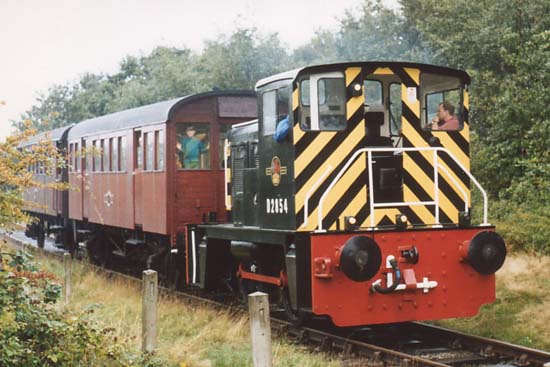- British Rail Class 02
Infobox Locomotive
name = British Rail Class 02
powertype = Diesel-hydraulic
caption = D2854 on theMiddleton Railway in 1994
roadnumber = D2850–D2869; later 02001–02004
builder = Yorkshire Engine Co.
builddate = 1960–1961
serialnumber = 2809–2818, 2843–2852
gauge = RailGauge|ussg|lk=on
primemover = Rolls-Royce C6NFL176
enginetype =Straight-6 diesel
transmission = Rolls-Royce 10,000-series 3-stage twin-disc torque converter, manually operated YEC reduction and reversing final drive gearbox
whytetype =0-4-0
uicclass = B
wheeldiameter = convert|3|ft|4|in|m|3|abbr=on
minimumcurve = convert|1|chain|m|lk=on
trainbrakes = Vacuum
locobrakeforce = convert|21|LTf|kN|abbr=on|lk=in
wheelbase = convert|6|ft|0|in|m|2|abbr=on
length = convert|21|ft|11+1/2|in|abbr=on
width = convert|8|ft|6|in|m|2|abbr=on
height = convert|11|ft|5+1/4|in|abbr=on
weight = convert|28.60|LT|lk-=on
topspeed = convert|19.5|mph|km/h|1|abbr=on|lk=on
poweroutput = "Engine:" convert|170|hp|abbr=on|lk=on
"At rail:" convert|100|hp|abbr=on
tractiveeffort = convert|15000|lbf|kN|1|abbr=on|lk=on (max)
fuelc
convert|300|impgal|abbr=on|lk=on
axleloadclass = RA 2
railroad =British Railways
numinclass = 20TheBritish Rail Class 02 were a class of twenty0-4-0 diesel-hydraulic shuntinglocomotive s built by theYorkshire Engine Company in1960 (first ten, D2850-D2859) and1961 (D2860-D2869) for service in areas of restrictedloading gauge and curvature such as docks. They had the door to the cab at the rear, with a railed veranda behind the cab; this feature was very unusual on British Rail locomotives although was used on many Yorkshire Engine Co. designs and was/is quite normal inNorth America n practice.Post-BR use
With the changes in the role of the British railway system and the closing of many of the facilities in which the Class 02 locomotives worked, they were increasingly surplus to requirements. The first locomotive was withdrawn from service in 1969 and the last one in 1973. Only three survived long enough to enter the BR TOPS computer system: 02 001 (formerly D2851), 02 003 (D2853), and 02 004 (D2856). Being only nine to fourteen years old when withdrawn, they still had a lot of life left in them, and the majority were sold to private industry.
Preservation
A large number (at least seven) are now in preservation, where their small size makes them perfect as a workshop shunter or for use in track maintenance work. One (D2860) is the works shunter for the
National Railway Museum inYork , where it is used to move much larger exhibits around.* D2854 by
Heritage Shunters Trust
* D2858 atMidland Railway, Butterley
* D2860 at National Railway Museum, York
* D2866 byHeritage Shunters Trust
* D2867 "Diane" atBattlefield Line Railway
* D2868 "Sam" byHeritage Shunters Trust Technical details
The engine is a Rolls-Royce C6NFL176 6-cyl. in-line connected to a Rolls-Royce series 10,000 3-stage twin-disc torque converter and a manually operated YEC reduction and reversing final drive gearbox. The engine and transmission are mounted at an angle of 30 degrees to the horizontal to allow the overall length and height of the locomotive to be reduced.
Unlike most earlier British Rail shunters, the Class 02s were built with train vacuum brakes.
Industrial locomotives
In addition to these locomotives produced for
British Railways , around 50 very similar locomotives (most withdiesel-electric transmission and/or more powerful engines) were produced for industrial customers. Many of these can now be found in preservation also, since few industrial users have their own railways anymore. Quite a few are dressed up in fictitious British Railways livery and numbering (for example - 02 101).External links
* [http://www.therailwaycentre.com/Pages%20Loco/Recognition%20loco/Illus_02.html Photos at TheRailwayCentre.com]
Wikimedia Foundation. 2010.
